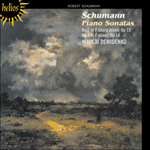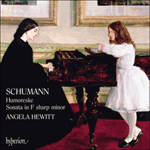
Welcome to Hyperion Records, an independent British classical label devoted to presenting high-quality recordings of music of all styles and from all periods from the twelfth century to the twenty-first.
Hyperion offers both CDs, and downloads in a number of formats. The site is also available in several languages.
Please use the dropdown buttons to set your preferred options, or use the checkbox to accept the defaults.

| Nikolai Demidenko (piano)» More |


The Allegro is dominated by what Schumann called his ‘fandango’ idea. The only significant contrast is provided by a smooth theme in the major that emerges at the end of the exposition, fulfilling the role of a traditional second subject. Even here, though, the falling fifth motif, with its dotted rhythm surviving intact, is absorbed as an accompanimental figure.
Schumann describes the slow movement as an ‘Aria’, and it is in fact based on a song he had written as an eighteen-year-old student. (The song, An Anna, to a poem by Justinus Kerner, was not published until Brahms included it in the supplement to the collected edition of Schumann’s works, issued in 1893.) In Schumann’s piano setting the beginning of the melody significantly unfolds over a sustained perfect fifth in the bass, and its delicate air of understatement is underlined by the marking of senza passione, ma espressivo. When Liszt reviewed the sonata for the Paris Gazette musicale (alongside the F minor Sonata, Op 14, and the Impromptus on a Theme of Clara Wieck, Op 5) he singled out the slow movement for special praise, describing it as ‘a song of great passion, expressed with fullness and calm’. The falling fifths that punctuate the melody are not found in the original song, and were clearly added in order to stress the unity of the sonata’s opening pair of movements.
Behind the framework of the third movement lies the notion of a through-composed scherzo with two trios. The tempo quickens for the first quasi-trio whose opening bars are underpinned by the first movement’s ‘rocking’ fifths motif, played pianissimo leggierissimo. The second trio—or ‘Intermezzo’ as Schumann calls it—is written very much tongue-in-cheek. It abruptly abandons the agitated, adventurous style of the piece thus far in favour of what seems to be a parody of the old-fashioned school. The episode is, in essence, an absurdly heavy-handed polonaise, and Schumann marks it, appropriately enough, Alla burla, ma pomposo. There is little doubt that we are here face to face with a Papillon—perhaps an extract from the lost set of ‘XII Burlesken (burle) in the style of Papillons’ which Schumann had sent to the publishers Breitkopf und Härtel in 1832.
There is a further surprise in store before the scherzo is allowed to return, in the shape of an orchestrally inclined recitative complete with a ‘Papillon’ that takes flight on the oboe before being angrily dismissed by the full band. And to add to the confusion, the scherzo returns at the wrong pitch before being thrown into the correct key a couple of bars later—a typically Schumannesque touch.
There are more orchestral sonorities in the finale: tremolos deep in the bass register while above them the texture gradually increases in weight, like a crescendo over a drum roll; a staccato passage near the close, marked quasi pizzicato; tutti chords punched out at top speed (one of several features in the piece that make it a formidable technical challenge to the pianist). This sonata-rondo based on a duple-metre theme forced into the strait-jacket of three beats to the bar was, in fact, the first part of the sonata to be composed. If it lacks the coherence and dramatic sweep of the opening movement, the music’s élan and inventiveness carry the listener unfailingly through to its triumphant F sharp major conclusion.
from notes by Misha Donat © 1996
L’Allegro est dominé par ce que Schumann appela son idée de «fandango». Le seul contraste important est fourni par un thème paisible, en majeur, qui surgit à la fin de l’exposition et joue le rôle d’un second sujet traditionnel. Même là, cependant, le motif de la quinte descendante, au rythme pointé demeuré intact, est absorbé comme figure d’accompagnement.
Le mouvement lent, désigné comme une «Aria», repose en fait sur une chanson composée par Schumann à dix-huit ans, alors qu’il était étudiant. (Cette chanson, An Anna, sur un poème de Justinus Kerner, resta inédite jusqu’à ce que Brahms l’inclût dans le supplément de l’édition des œuvres complètes de Schumann, publié en 1893.) Dans la mise en musique pour piano de Schumann, le début de la mélodie se déploie, fait révélateur, sur une quinte juste tenue, dans la basse, tandis que l’indication senza passione, ma espressivo souligne son délicat air d’amoindrissement. Dans la critique qu’il consacra à cette sonate (en même temps qu’à la Sonate en fa mineur, op. 14, et aux Impromptus sur un thème de Clara Wieck, op. 5), dans la Gazette musicale de Paris, Liszt loua tout particulièrement le mouvement lent, qu’il décrivit comme «un chant d’une grande passion, exprimé avec plénitude et calme». Les quintes descendantes qui ponctuent la mélodie ne se trouvent pas dans la chanson originelle et furent à l’évidence ajoutées pour faire ressortir l’unité de la paire de mouvements initiale de la sonate.
La trame du troisième mouvement cèle la notion d’un scherzo de forme ouverte, avec deux trios. Le tempo s’accélère pour le premier quasi trio, dont les mesures d’ouverture sont étayées par le motif de quintes cullando du premier mouvement, joué pianissimo leggierissimo. Le second trio—que Schumann baptise «Intermezzo»—présente une écriture très ironique. Il abandonne brusquement le style agitée aventureux, pour ce qui semble une parodie de l’école d’autrefois. Fondamentalement, cet épisode est une polonaise absurdement lourde, que Schumann marque, fort opportunément, Alla burla, ma pomposo. Il est possible que nous nous trouvions en présence d’un Papillon—peut-être un extrait du corpus perdu des «XII Burlesken (burle) dans le style de Papillons», que Schumann avait envoyé aux éditeurs Breitkopf und Härtel en 1832.
Avant que le scherzo puisse revenir, une autre surprise nous attend, sous la forme d’un récitatif plutôt orchestral avec un «Papillon» qui prend son envol sur le hautbois mais est rejeté à l’unanimité, avec colère. Pour ajouter à la confusion, le scherzo revient à la mauvaise tonalité pour être lancé dans le mode correct deux mesures plus tard—une touche typiquement schumannesque.
Le finale comporte encore de sonorités orchestrales: des trémolos profonds dans les graves, par-dessus lesquels la texture gagne de plus en plus en poids, tel un crescendo sur un roulement de tambour; un passage staccato près de la fin, marqué «quasi pizzicato»; des accords tutti lâchés à vitesse maximale (une des caractéristiques qui font de ce morceau un formidable défi technique pour le pianiste). Cette sonate-rondo, fondée sur un thème à deux temps contraint dans la camisole d’une mesure à trois temps, était en fait la première partie de la sonate à être composée. Bien que dépourvue de la cohérence et de l’ampleur éclatantes du mouvement initial, la musique, forte de son élan et de son inventivité, entraîne l’auditeur, sans faillir, jusqu’à la conclusion triomphante en fa dièse majeur.
extrait des notes rédigées par Misha Donat © 1996
Français: Hypérion
Das Allegro wird von der „Fandango“-Idee, wie Schumann sie nannte, dominiert. Der einzige bemerkenswerte Unterschied ist ein ruhiges Thema in Dur, das gegen Abschluß der Exposition ertönt und die Rolle eines traditionellen zweiten Themas übernimmt. Obwohl das Motiv der absteigenden Quinten nun in einer begleitenden Figur versinkt, bleibt sein punktierter Rhythmus intakt.
Schumann bezeichnete den langsamen Satz, der auf einem Lied basiert, das er als achtzehnjähriger Student geschrieben hatte, als „Arie“. (Das Lied, An Anna, zu Worten von Justinus Kerner wurde erst veröffentlicht, als Brahms 1893 Schumanns gesammelte Werke herausgab.) In Schumanns Klaviervertonung entwickelt sich der der Melodienanfang bezeichnend über einer gehaltenen, vollkommenen Quinte der Baßstimme, und die zart angedeutete Untertreibung wird durch die Markierung mit senza passione, ma espressivo noch verstärkt. Als Liszt die Sonate (zusammen mit der Sonate in f-Moll, op. 14 und den Impromptus über ein Thema von Clara Wieck, op. 5) für die Pariser Zeitschrift Gazette musicale rezensierte, hob er den langsamen Satz als besonders lobenswert hervor und beschrieb ihn als „ein Lied großer Leidenschaft, die mit Fülle und Ruhe ausgedrückt wird“. Die die Melodie betonenden, absteigenden Quinten sind im ursprünglichen Lied nicht vorhanden und wurden zweifellos hinzugefügt, um die Einheit des eröffnenden Satzpaares der Sonate weiter zu betonen.
Hinter dem Gerüst des dritten Satzes offenbart sich das Konzept eines durchkomponierten Scherzos mit zwei Trios. Im ersten Quasi-Trio, dessen einleitende Takte vom „wiegenden“ Quintenmotiv, pianissimo leggierissimo, des ersten Satzes gestützt werden, wird das Tempo erhöht. Das zweite Trio—oder „Intermezzo“, laut Schumannn—wurde mit einem großen Maß an Ironie komponiert. Abrupt verwirft es zugunsten einer scheinbaren Parodie der altmodischen Schule den bisher erregten, kühnen Stil des Stückes. Das Zwischenspiel ist in seinem Kern eine absurd schwerfällige Polonaise, die Schumann recht passend mit Alla burla, ma pomposo markierte. Es ist kaum anzuzweifeln, daß wir es hier mit einem Papillon zu tun haben—vielleicht ein Auszug aus der verloren gegangenen Sammlung von „XII Burlesken im Stile von Papillons“, die Schumann 1832 an die Herausgeber Breitkopf und Härtel gesandt hatte.
Ehe das Scherzo wiederaufgenommen werden kann, steht uns in Gestalt eines orchestral ausgerichteten Rezitativs, vollständig mit einem auf der Oboe dahinfliegenden „Papillon“, den das ganze Orchester schließlich wütend in die Schranken weist, eine weitere Überraschung bevor. Um die Verwirrung komplett zu machen, wird das Scherzo in falscher Tonhöhe wieder aufgenommen, ehe es nach ein paar Takten schließlich in der richtigen Tonart erscheint—ein Kunstgriff ganz in der Manier Schumanns.
Das Finale verbreitet weitere orchestrale Wohlklänge: Tiefe Tremoli im Baßregister, über denen die Struktur allmählich an Gewicht zunimmt, ganz wie ein Crescendo über einem Trommelwirbel; eine mit „quasi pizzicato“ markierte Staccato-Passage am Ende; sehr schnelle, gehämmerte Tutti-Akkorde (eines der zahlreichen Charakteristika dieses Stückes, das für jeden Pianisten eine ausgezeichnete technische Herausforderung darstellt). Dieses Sonaten-Rondo, das sich auf ein in drei Schlägen je Taktstrich hineingezwungenes Thema in doppeltem Versmaß stützt, war tatsächlich der erste Teil jener Sonate, deren Komposition noch bevorstand. Sollte es dem einleitenden Satz auch an Kohärenz und Dramatik fehlen, so geleitet der élan und die Intensität der Musik den Hörer stets bis zum triumphierenden Abschluß in Fis-Dur.
aus dem Begleittext von Misha Donat © 1996
Deutsch: Ute Mansfeldt
 Schumann: Piano Sonatas Schumann: Piano Sonatas‘A pair of performances which can justly be described in terms of superlatives. Outstanding readings of remarkable works’ (Classic CD) ‘Originally recorded and released in 1996, Hyperion's decision to re-issue Nikolai Demidenko's performances of these sonatas on the Helios label is mo ...» More |
 Schumann: Humoreske & Sonata Op 11 Schumann: Humoreske & Sonata Op 11 |

